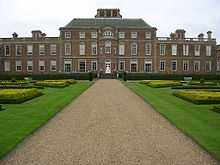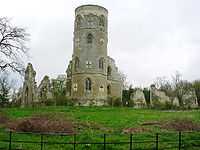Wimpole Hall

Wimpole Hall is a country house located within the Parish of Wimpole, Cambridgeshire, England, about 8 1⁄2 miles (13.7 kilometres) southwest of Cambridge. The house, begun in 1640, and its 3,000 acres (12 km2) of parkland and farmland are owned by the National Trust and are regularly open to the public.
Wimpole is the largest house in Cambridgeshire. Over the centuries, many notable architects have worked on it, including its first owner, Thomas Chicheley (between 1640 and 1670), James Gibbs (between 1713 and 1730), James Thornhill (1721), Henry Flitcroft (around 1749), John Soane (1790s), and H. E. Kendall (1840s).
Before the present Wimpole Hall was built in around 1640, there was a moated manor house set in a small 81 hectares (200 acres) deer-park. Situated to the north and south of this were three medieval villages: Bennall End, Thresham End and Green End. Wimpole Hall's grounds were laid out and modified by landscape designers such as George London and Henry Wise (1693–1705), Charles Bridgeman (1720s), Robert Greening (1740s), 'Capability' Brown (1767), and Humphry Repton (1801–1809). The parkland as it exists today is an overlay of the work of these landscape designers and gardeners, and was completed under the auspices of Elsie and George Bambridge. Elsie, the daughter of Rudyard Kipling, revitalised the house. Thanks to her efforts, this National Trust property is in the state it is in today.
Bridgeman's formal grand avenue sweeps away from the south front of the house for two and a half miles in contrast with the remainder of the park which was "naturalised" by Capability Brown. The North Park is particularly attractive with its belts of woodland, gentle rolling hills with individual trees and clumps of trees. The central feature of the North Park is the Gothic Tower and the restored lakes in the valley below.
In the grounds are a chain of lakes (1695–1767), a church (1749) - there are some pictures and a description of the church at the Cambridgeshire Churches website,[1] a folly (the false Gothic Tower; 1768), a farm (1792), a walled garden (18th century), and a stable block (1851).
-

Wimpole the entrance front
-

Wimpole Hall in 1880
-
Wimpole garden
-
Wimpole side gates
-
Wimpole's Folly, built in the 1700s to resemble Gothic-era ruins
-

The lake and Gothic folly in the grounds of Wimpole Hall
-

Wimpole the stable block
-

Wimpole glasshouses in the kitchen garden
Ownership
The owners of the modern estate, in chronological order, have been:
- 1640 Sir Thomas Chicheley (c.1613–1699)
- 1686 Sir John Cutler Baronet (1607-1693)
- 1689 Charles Robartes, 2nd Earl of Radnor (1660–1723) by marriage settlement as husband of Elizabeth (died 1697) daughter of Sir John Cutler
- 1697 Edmund Boulter (1635-1709) nephew of Sir John Cutler on the death of Elizabeth (Cutler) Robartes without heir
- 1710 John Holles, 1st Duke of Newcastle-upon-Tyne, 4th Earl of Clare (d.1711)
- 1711 Henrietta Holles daughter and heiress of above and from 31 August 1713 spouse of the next
- 1713 Edward Harley, 2nd Earl of Oxford and Earl Mortimer (1689–1741)
- 1739 Philip Yorke, 1st Earl of Hardwicke (1690–1764)
- 1764 Philip Yorke, 2nd Earl of Hardwicke (1720–1790)
- 1790 Philip Yorke, 3rd Earl of Hardwicke (1757–1834)
- 1834 Charles Yorke, 4th Earl of Hardwicke (1799–1873)
- 1873 Charles Yorke, 5th Earl of Hardwicke ('Champagne Charlie')
- 1894 Thomas Charles Agar-Robartes, 6th Viscount Clifden
- 1919 Francis Gerald Agar-Robartes, 7th Viscount Clifden
- 1938 Captain and Mrs George Bambridge
- 1976 The National Trust
Community Use
Like many other estates managed by the National Trust, a range of organised events and less formal access arrangements now use Wimpole Park. In 2013, a national partnership between the Trust and parkrun lead to the establishment of a weekly 5km run around the park, currently enjoyed by over 100 participants every Saturday at 9am.
External links
| Wikimedia Commons has media related to Wimpole Hall. |
- Wimpole Hall information at the National Trust
- Welcome to Wimpole
- Gardens Guide information
- Wimpole Estate parkrun
References
Coordinates: 52°08′28″N 0°02′59″W / 52.1411°N 0.0498°W


